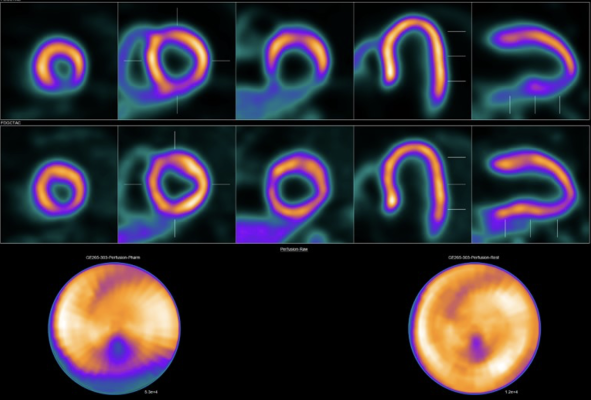
Figure 1. Image showing abnormal 18F-flurpiridaz PET (stress top, rest bottom) for a 60-year-old female with body mass index of 46 kg/m2; subsequent angiography showed significant blockage in right coronary artery.
June 28, 2023 — A novel PET perfusion radiotracer, 18F-flurpiridaz, can diagnose coronary artery disease (CAD) in obese patients with a higher sensitivity and specificity compared to 99Tc-SPECT myocardial perfusion imaging (MPI), according to research presented at the 2023 Society of Nuclear Medicine and Molecular Imaging Annual Meeting. 18F-flurpiridaz PET MPI obtained images at a lower radiation dose than 99Tc-SPECT MPI and performed similarly in both obese and non-obese patients.
Obese individuals frequently have medical conditions such as diabetes, high cholesterol, and high blood pressure that put them at higher risk of developing CAD. Due to these risk factors, imaging obese patients for CAD is very important.
“Due to their body shape, it’s often hard to image obese individuals,” said Krishna Patel, MD, assistant professor of medicine and cardiology at the Icahn School of Medicine At Mount Sinai in New York. “This can result in inferior image quality and diagnostic performance despite requiring a higher dose of radiation.”
The study reports on a pre-specified subgroup of a phase III multicenter trial of 18F-flurpiridaz. A total of 604 patients with suspected CAD across 48 sites in the United States, Canada and Europe were enrolled in the study. Patients underwent one-day rest-stress 18F-flurpiridaz PET MPI or one- or two-day rest-stress 99mTC-SPECT MPI before undergoing invasive coronary angiography. MPI images were read by three experts blinded to clinical and invasive coronary angiography data. Sensitivity and specificity for 18F-flurpiridaz PET MPI and 99mTC-SPECT MPI were calculated and then compared between PET and SPECT MPI among obese and non-obese groups.
Of the 578 patients with evaluable studies, 298 (51.6 percent) were classified as obese. 18F-flurpiridaz PET MPI had a sensitivity of 77 percent and a specificity of 67 percent in diagnosing significant CAD, while 99mTC-SPECT MPI had a sensitivity of 69.2 percent and specificity of 61.9 percent. The sensitivity, specificity and accuracy of 18F-flurpiridaz PET MPI was similar in non-obese and obese sub-groups.
“Our research shows that 18F-flurpiridaz stress cardiac PET imaging is excellent for diagnosing significant coronary artery disease even in obese patients, and at a lower radiation dose than traditional 99mTC-SPECT MPI,” stated Patel.
Patel also noted that 18F-flurpiridaz could significantly increase availability of and access to PET myocardial perfusion imaging across the country, and potentially all over the world. “We know that PET perfusion is the best noninvasive imaging modality for CAD; however, thus far, the availability of stress cardiac PET myocardial perfusion imaging is limited across the world, as both significant investment for the generator and large patient volume are required for it to make economic sense,” she said. “With availability as a unit dose, 18F-flurpiridaz can disrupt this space, as suddenly now most—if not all—centers that offer PET for oncology can now perform stress perfusion studies.”
For more information: www.snmmi.org
Find more SNMMI23 conference coverage here


 April 16, 2025
April 16, 2025 








